
Kinston is a city in Lenoir County, North Carolina, United States, with a population of 19,900 as of the 2020 census. It has been the county seat of Lenoir County since its formation in 1791. Kinston is located in the coastal plains region of eastern North Carolina.
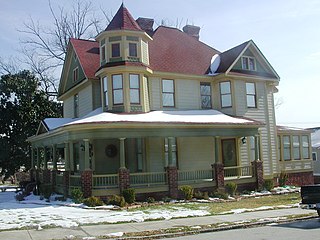
Southside is an urban neighborhood in the south central section of the United States city of Greensboro, North Carolina. Southside has also been known as the Ol' Asheboro neighborhood, Arlington Park, the Asheboro Street neighborhood, and the South Greensboro neighborhood, Gorrell Street Neighborhood Association. Located in downtown Greensboro, its streets are lined with historic Queen Anne mansions and bungalows, complemented by new development that has attracted a diverse population. The downtown neighborhood has received several national awards including the 2003 Outstanding Planning Award, the 2004 National Award for Smart Growth and in 2005 the Sierra Club named the Southside Neighborhood in the top 12 as one of America's best new developments

Hilltop Manor is an historic apartment complex located in Bladensburg, Prince George's County, Maryland. The complex consists of eight brick garden apartment buildings, each of which is divided into two to six units or sections, constructed in 1942 and 1943.

The Whittier is a partially renovated high rise residential complex and former hotel located at 415 Burns Drive in Detroit, Michigan, on the Detroit River. It was listed on the National Register of Historic Places in 1985.
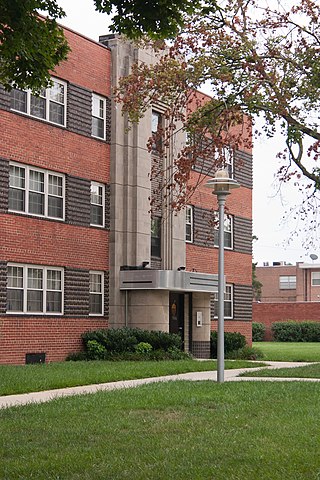
Samester Parkway Apartments is a historic apartment complex located at Baltimore, Maryland, United States. The 72-unit complex consists of two symmetrical detached wings, massed as stacked chevrons of six apartment buildings each, that face each other across a central courtyard. They are three-story, red brick, garden apartment structures. The complex was constructed in 1939 in the Art Deco style. It is an early example of Federal Housing Administration-financed garden apartments in Baltimore and is an excellent example of the American translation of European modern architectural style. On May 28, 2004, 3 children were beheaded in the apartments.

The River Terrace Apartments is an apartment building located at 7700 East Jefferson Avenue in Detroit, Michigan. It was listed on the National Register of Historic Places in 2009. River Terrace Apartments was one of the first two garden apartment complexes built in Michigan which used loan guarantees from the Federal Housing Administration, the other being Hillcrest Village in East Lansing.
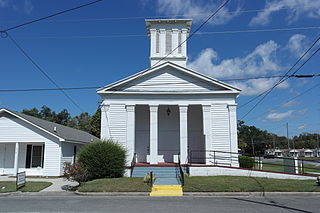
Kinston Baptist-White Rock Presbyterian Church is a historic Presbyterian and Baptist church building located at 516 Thompson Street in Kinston, Lenoir County, North Carolina. It was built in 1857–1858, and is a rectangular, temple-form Greek Revival style frame building with a pedimented front gable roof. It features a bold distyle in antis portico with enclosed end bays. The church was built for the Kinston Baptist Church and moved to its present (third) location in 1901 after its purchase by an African-American Presbyterian congregation which it has served since that time.
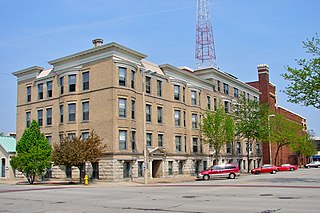
The Sala Apartment Building is a historic building located in Rock Island, Illinois, United States. It was individually listed on the National Register of Historic Places in 2003. In 2020 it was included as a contributing property in the Downtown Rock Island Historic District.

The Frederick Apartments is a historic apartment building located in Charlotte, Mecklenburg County, North Carolina. It was built in 1927, and is a three-story, 36-unit brick apartment house in the Italian Renaissance Revival style. The body of the building is constructed of red brick, laid up in common bond. The facade features buff-colored brick set in stretcher bond with decorative patterning in places.

Ottari Sanitarium, also known as the Coburn Apartments, is a historic building complex located at 491 Kimberly Avenue in Asheville, Buncombe County, North Carolina. The original section was built in 1912, and now forms the east end of the building. It is a three-story, stuccoed brick building with a hipped roof. It was enlarged in 1923, with the addition of a three-story, 14 bay brick addition, connected to the original building by a two-story section. The building was converted to apartments in 1937.

Robert L. Blalock House is a historic home located at Kinston, Lenoir County, North Carolina. It consists of the original two-story, three-bay, double-pile, side-hall-plan Greek Revival style main block dated to the 1850s, and a large, two-story rear ell. It has a one-story gable-roofed wing and a small shed-roofed room north of the rear ell and a complex arrangement of one- and two-story additions and enclosed porches to the south. The house was renovated in the 1920s in the Classical Revival style. It features a full-width front porch supported by groups of square-section brick columns with a round corner pavilion and porte-cochère. It has housed a funeral home since 1947.

Hotel Kinston is an historic hotel building located at Kinston, Lenoir County, North Carolina. It was built in 1927–1928, and is an 11-story, steel frame Art Deco-style building. It is sheathed in red brick with cast stone Moorish stylistic details at the main entrance and top floors. It was operated as a hotel until the 1960s. It houses senior citizen apartments.

American Tobacco Company Prizery, also known as the Nantucket Warehouse, is a historic tobacco prizery located at Kinston, Lenoir County, North Carolina. It was built in 1901 by the American Tobacco Company, and is a two-story, load-bearing brick building that was constructed in five phases beginning about 1901. The facility’s “prizery” name refers to its specialized function, the operation of a screw press to pack tobacco in hogsheads for shipping.

Addison Apartments is a historic apartment building located at Charlotte, Mecklenburg County, North Carolina. It was built in 1926, and is a nine-story, steel frame building sheathed in light brick and cast stone. The Classical Revival style building consists of a two-story base, six-story shaft, and one-story capital with a distinctive stepped pediment. The front facade features a two-story portico with a deck.

Orient Manufacturing Company-Chadwick-Hoskins No. 3, also known as Alpha-Orient Cotton Mill, is a historic cotton mill located at Charlotte, Mecklenburg County, North Carolina. It was built in 1901–1902, and is a two-story, Romanesque Revival style brick building. It incorporates portions of an original mill building built about 1889. The building has a low, front gable roof with exposed rafters, brick exterior walls, and segmental arched windows. It features a three-story staircase tower with a castellated parapet, tall, narrow windows, and a round arched entrance.

Joy Lee Apartment Building and Annex is a historic apartment building located at Carolina Beach, New Hanover County, North Carolina. The original building was built in 1945, and is a two-story, double-pile concrete block building covered with stucco. It features fanciful concrete balustrades and walls, and an Art Deco-inspired centered portico over the front entryway added in 1957. A two-story double-pile Modern Movement style Annex comprising four apartments was built in 1948.

Boylan Apartments is a historic apartment complex located in Raleigh, Wake County, North Carolina. The three buildings were built in 1935, and are three-story, Colonial Revival style brick buildings arranged in a "U" shape plan around an open courtyard. Each building consists of 18 one and two-bedroom units. They were designed by the architectural firm Linthicum & Linthicum and built with funds supplied by the Public Works Administration (PWA).
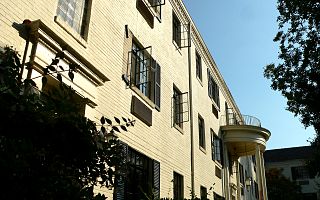
Grosvenor Gardens Apartments is an historic apartment complex located at Raleigh, Wake County, North Carolina. The three-story, Colonial Revival style brick building was constructed in 1939 and consists of a “U” shape plan around an open landscaped courtyard. It is a pedimented gable-roofed structure with symmetrically arranged three- and five bay units, three of which feature two-story convex porticos facing the center courtyard. There are 58 studio apartmetns, one basement apartment with one bedroom, one two-bedroom apartment, one three-bedroom apartment, and a laundry room in the complex.

Craven Terrace is a historic apartment complex located at New Bern, Craven County, North Carolina. The complex was built in two stages in 1942 and 1953, and consists of 46 apartment buildings, a one-story brick community building (1942). The buildings include elements of Colonial Revival and Moderne style design elements. The brickwork of the 1953 apartments and maintenance building are laid in six courses of stretchers to a course of Flemish bond. The complex was built as a low-income residential development for African American residents of New Bern and was funded by the United States Housing Authority.

Linwood Colonial Apartments, also known as Colonial Park Apartments, is a historic garden apartment complex and national historic district located at Indianapolis, Indiana. It was built in 1937–1938, and consists of three three-story, Colonial Revival style red brick buildings. It has 106 apartments and includes a U-shaped building and two stepped plan buildings.
























